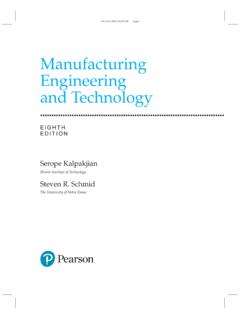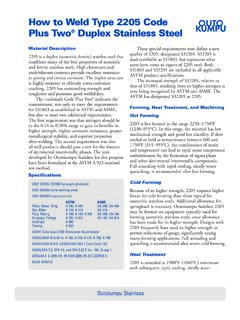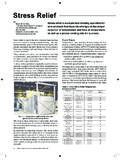Transcription of SELECTION OF DIE MATERIALS AND SURFACE TREATMENTS …
1 1 SELECTION OF DIE MATERIALS AND SURFACE TREATMENTS FOR INCREASING DIE LIFE IN HOT AND WARM FORGING Mayur Deshpande, Research Associate and Adam Groseclose, Graduate Research Associate and Dr. Taylan Altan, Professor and Director, ERC for Net Shape Manufacturing, The Ohio State University, 339 Baker Systems, 1971 Neil Ave, Columbus OH 43201 USA ABSTRACT In warm and hot forging, the dies are subjected to high contact pressures and temperatures. The SELECTION of the die material, hardness and coating is critical for increasing die life.
2 Recent studies indicate that ceramic dies and various SURFACE treatment techniques represent, in certain applications, cost effective techniques for improving die life. This paper reviews the state of technology on die MATERIALS and SURFACE TREATMENTS used in hot and warm forging of steel . Finite Element Analysis (FEA) based methods have also been used to estimate abrasive wear and plastic deformation on forging dies. These estimations can help to determine how process conditions, ram velocity, contact time, lubrication and strokes/min, can affect die life.
3 2 1 INTRODUCTION In this review paper, some of the commercially available die MATERIALS were compared based on their hardness data available in material data sheets. These MATERIALS are used for hot and warm forging in mechanical presses. This paper also includes the results of a study by ERC/NSM, in which wear and plastic deformation on warm forging dies was successfully estimated by using Finite Element Analysis. Some of the studies on ceramic die MATERIALS presented in literature were reviewed. SURFACE treatment techniques such as nitriding and weld overlays, as well as ceramic coatings, are also discussed.
4 In hot and warm forging, mainly hot work die steels are used due to their ability to retain their hardness at elevated temperatures with sufficient strength and toughness to withstand the stresses that are imposed during forging. There have also been some cost effective applications of other MATERIALS such as ceramics, carbides and super alloys although these applications are limited due to design restrictions and costs. Hot working die steels used at temperatures between 310 C and 650 C contain additions of chromium, tungsten, vanadium and molybdenum to provide deep hardening characteristics and resistance to abrasion and thermal softening at high temperatures.
5 Molybdenum increases resistance to thermal softening, vanadium improves wear and thermal fatigue characteristics. Tungsten alloy steels are not resistant to thermal shock and must not be cooled intermittently with water (1). The SELECTION of die steel largely depends on the temperature developed in the dies, the load applied and the mode of cooling of the dies. Most hot work tool steels are low carbon steels with medium or high alloying elements (6F and H series). The compositions of the AISI grade hot work tool steels are given in literature. Chromium hot work steels (H10, H11, H13, H14 and H19) are the most commonly used for forging applications.
6 In general, chromium die steels retain their hardness upto 425 C, tungsten hot work steels (H21 to H26) retain much of their hardness upto to 620 C. The properties of molybdenum based hot work steels is in between that of chromium based and tungsten based hot work die steels. Thermal and mechanical properties of various AISI standardized hot work tool steels is available in many books, hence have not been listed here (1). Apart from the AISI standardized die steels, many manufacturers have standardized MATERIALS which are either having the composition similar to the AISI standard or their variants based on the alloy contents and the heat treatment used.
7 Some commercially available hot work die steels which are suitable for use in hot and warm extrusion are listed in Table 1. The compositions and the hardness ranges recommended by the manufacturer are also shown in the table. Except DRM1 and DURO F1 die MATERIALS , all other MATERIALS were regular Chromium and Molybdenum based hot working die steels. These MATERIALS are suitable for the forging die inserts and other surrounding tooling. DRM1 and DURO F1 are matrix high speed steels (MHSS) which are suitable for 3 forging punches. MHSS usually contain higher percentage of tungsten or molybdenum which provides high hardness to the dies.
8 To understand the performance of the nine MATERIALS , the data obtained from the individual data sheets was compared. Table 1: Composition of MATERIALS considered suitable for hot forging tooling SELECTION of material for forging dies primarily depends on their resistance to wear, plastic deformation and fatigue (mechanical and thermal). To provide resistance to wear and plastic deformation, the dies hardness should be as high as possible. But the dies should also have adequate toughness as the dies are subjected to changes in pressures and temperatures. Hot work die steels are usually subjected to a heat treatment cycle prior to use (Figure 1).
9 After hardening (by quenching) they are also usually tempered (once or multiple times) to provide enough toughness. Tempering temperature is the temperature at which the dies are held after hardening. As the tempering temperature is increased, the hardness achieved after tempering decreases. So, the toughness required for the dies sets the limit of maximum hardness that the dies can be used. The tempering curves for some of the die MATERIALS investigated are given in Figure 2. The tempering temperature also defines the working temperature range for the dies. During forging, if the temperature on the dies exceeds the tempering temperature, the dies soften and lose their hardness quickly.
10 4 Figure 1: Heat treatment cycle of hot work tool steels (2). After the dies are tempered the initial room temperature hardness can be determined. During forging, as the die SURFACE is subjected to high temperature, the hardness of the die decreases. Even if the initial hardness for a material is high, if the hardness drops down as the temperature is increased then the dies are favourable. Die MATERIALS are considered to be better if they are able to retain their hardness at elevated temperature they should have better hot hardness properties. The variation of hot hardness of five die MATERIALS are as shown in Figure 3.








